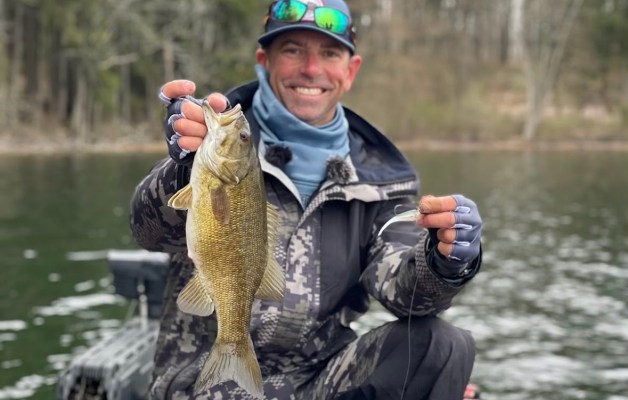| |
| Name: | Gary Yamamoto |
| Hometown: | Palestine, Texas |
| Technique: | Stickworm fishing. The Senko from Gary Yamamoto Custom Baits is the original soft plastic stickworm. It was designed to be a jerkbait, but found greater popularity as a finesse bait. |
| History: | Yamamoto never planned on creating a bait company or one of the most revolutionary soft plastics in bass fishing history. It was pure happenstance. He was simply trying to improve on an existing design. Since then, Yamamoto has built a tackle empire on the original 5-inch Senko, and its wild success has since spawned a full line of soft plastics and another bait company, Kinami. “I originally wanted to make a twitch bait like the Slug-Go,” Yamamoto says, “but after the initial phase of testing it turned out that the Senko was better as a finesse bait.” As for the name, Yamamoto says his son picked it out of the Japanese dictionary. He was looking for the word “flash,” which has a lot of names in Japanese. He liked “senko” best. |
| Highlights: | While he has used the Senko extensively in tournaments, Yamamoto’s most cherished moment with his bait was in the early stages of its development. “I was out on Sam Rayburn and saw a fish on a bed. When I casted to it I missed by 4 feet and thought I had to try again because they typically ignore things that aren’t in the bed. As the bait fell, I saw the fish come off the bed and pick it up. That’s when I knew there was something special about it.” |
| When to Use: | Yamamoto says the Senko works all year round, but shines from spring to fall. During the colder months, Yamamoto finds success in deeper water on long underwater structure such as points. When fishing it in deeper water, a small weight is recommended. |
| Where to Use: | Yamamoto says the Senko is best in shallow water, especially in spawning areas in early spring. However, he has caught fish in cold water from as deep as 30 feet at Beaver Lake. Shallow cover, such as grass and stumps are good, while bluffs are tailor-made for throwing a Senko. |
| Tackle: | Depending on the size Senko you’re using, Yamamoto prefers a 3/0 or 4/0 extra wide gap (EWG) hook, 8- to 12-pound test fluorocarbon line and a medium or medium-heavy action rod. This combination of light line and a medium action rod allows for long casts and positive “pressure” hook sets — a swift jerk is not recommended. Fluorocarbon line is preferred over monofilament because its density allows it to sink with the bait and does not interfere with the fluttering action the Senko is famous for. When weights are desired, 1/8- to 1/4-ounce screw-lock weights work best. |
| Lures: | Yamamoto’s design proves that there is beauty in simplicity. “I got the idea for the shape from a Bic pen I had. I made up some wood prototypes then called the office and told them to make a mold from this pen.” Senkos come in sizes from 2 inches up to 7 inches and in myriad colors. One model even features a swimming tail. |
| Basics: | The Senko is a finesse bait, but can be worked in a few ways. The most popular way to use it is without a weight of any kind. Simply rig it as you would on a Texas rig and skin hook it with the point just under the surface of the plastic. It’s important that the bait hangs as straight as possible on the hook, otherwise the signature fluttering action of the bait will be lost. If skipping a Senko under a dock, the wacky rig is a good option. Wacky rigging is simple, but not very weedless. The worm is impaled through the middle much like a live nightcrawler. A third option is to weight the Senko. Yamamoto will fish it weighted if he wants a different look or is in deep water (10 or more feet). He says a 1/8-ounce screw-lock weight is best because it stays with the worm and makes it spiral as it falls. The simplicity of the Senko doesn’t s”top” with the design. It’s also a simple bait to use. Yamamoto says while he designed the Senko to be a jerkbait, few people use it that way. The action on the fall is what draws the most strikes. Yamamoto will cast it to shallow cover and simply let the worm fall. The fluttering action draws the strikes. Yamamoto says the slower you fish the Senko, the better. After watching the line to see when the bait is on the bottom, Yamamoto will let it sit for several seconds, then raise the rod tip 6 inches or a foot, then let the bait flutter down again. Repeat this until the bait is no longer near any cover. “When the fish hear the splash, they look to see what it is. When they see the worm, they may not grab it right away, but go over and inspect it. When they get a good look at it and it moves again, that’s when most strikes occur.” Once you feel pressure from a fish, Yamamoto says a jarring hook set is not needed. Since the worm is skin-hooked, all you need to do is reel until the line is tight and allow the fish to set the hook for you as it swims away. |
| One More Thing: | The most common mistake Yamamoto sees from anglers is fishing too fast. “This bait is very subtle. It needs to be worked slowly. From the time it splashes and falls, it only needs to be moved a little bit to get good action out of it. The slower a fisherman is, the better he is.” |




